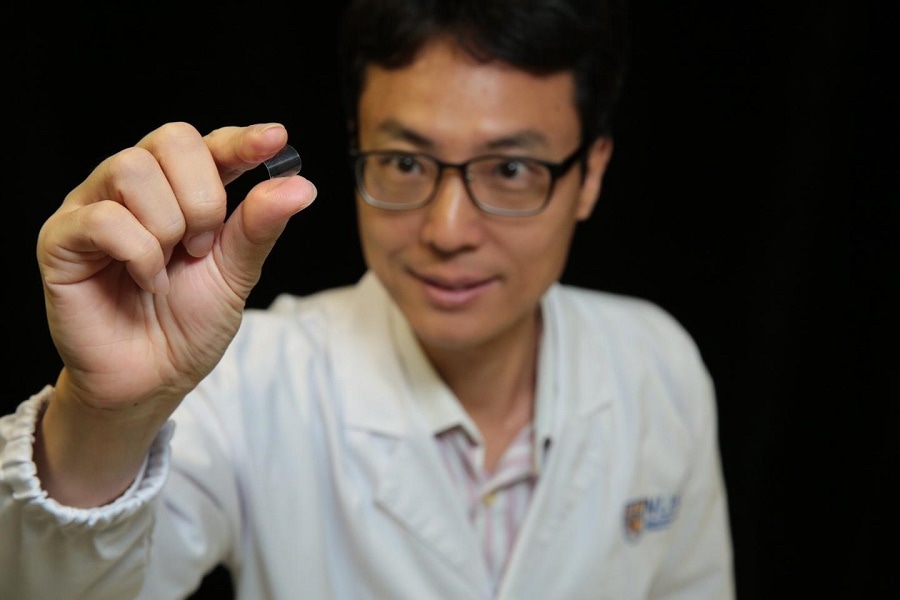Jul 20 2016
Implanting magnetic memory chips on flexible plastic surfaces, while ensuring high performance, can now be done with a new method.
 Associate Professor Yang Hyunsoo from the National University of Singapore, who led a research team to successfully embed a powerful magnetic memory chip on a plastic material, demonstrating the flexibility of the memory chip. (Credit: National University of Singapore)
Associate Professor Yang Hyunsoo from the National University of Singapore, who led a research team to successfully embed a powerful magnetic memory chip on a plastic material, demonstrating the flexibility of the memory chip. (Credit: National University of Singapore)
The small piece of plastic with minute engravings is deceptively simple looking, and it is transparent and flexible enough to be rounded into a tube. However, the plastic is “smart” and has the potential to store and process data. This new invention was designed by scientists at the National University of Singapore (NUS), and the groundbreaking development is the next step in the path towards flexible, wearable electronics and is a significant milestone in the flexible electronics revolution.
The research is a collaboration project with scientists from Ghent University, Singapore's Institute of Materials Research and Engineering and Yonsei University. The researchers have implanted a malleable memory chip on a flexible piece of plastic. The memory chip is of major significance in designing and creating light and flexible devices. These devices can be used in various applications including industrial robotics and motor control, healthcare electronics, automotives, industrial energy and power management, and avionic systems and military, as well.
The team was headed by Associate Professor of the Department of Electrical and Computer Engineering at the NUS Faculty of Engineering, Yang Hyunsoo. A detailed report of the research and its results has been published in the July 6 issue of Advanced Materials.
Flexible, High-Performance Memory Devices a Key Enabler for Flexible Electronics
In recent years, a lot of research has been conducted on flexible electronics. The subject of flexible memory systems have enjoyed particular attention due to the fact that they are significant components that are essential for storing and processing data in biomedical systems and wearable electronics that need to be capable of wireless communication, code processing and information storage.
A lot of research has gone into the study of various forms of memory chips and different types of materials. However, a lot of challenges regarding the design and development of memory chips on flexible, soft substrates while maintaining the standard of performance persist.
In order to overcome these challenges Yang and team came up with a new means of implanting memory chips with high performance rates on flexible plastic surfaces.
The device developed by the team runs on magnetoresistive random access memory (MRAM) and uses a magnesium oxide (MgO)-based magnetic tunnel junction (MTJ) for data storage. MRAM is better than the traditional Random Access Memory (RAM) in a number of ways, including power consumption, processing speed, and its ability to retain data even after a power shutdown.
Novel Technique to Implant MRAM Chip on a Flexible Plastic Surface
As the first step, the team developed the MgO-based MTJ on a silicon base, which they later tore off from the silicon. The magnetic memory chip was implanted on a flexible plastic surface, which is made of polyethylene terephthalate, using a transfer printing technique, by manipulating the amount of strain caused by placing the chip on the plastic surface.
Our experiments showed that our device’s tunneling magnetoresistance could reach up to 300 per cent – it’s like a car having extraordinary levels of horsepower. We have also managed to achieve improved abruptness of switching. With all these enhanced features, the flexible magnetic chip is able to transfer data faster. Flexible electronics will become the norm in the near future, and all new electronic components should be compatible with flexible electronics. We are the first team to fabricate magnetic memory on a flexible surface, and this significant milestone gives us the impetus to further enhance the performance of flexible memory devices and contribute towards the flexible electronics revolution.
Yang Hyunsoo, Associate Professor, NUS
South Korea and U.S patents have been given for the technology created by this research team. Further studies to enhance the magnetoresistance of the system by tweaking the amount of strain in the magnetic structure is being conducted by the team, which has plans to apply the technology to other electronic components. They are also looking to work with companies in the industry to find out more applications for their technology.